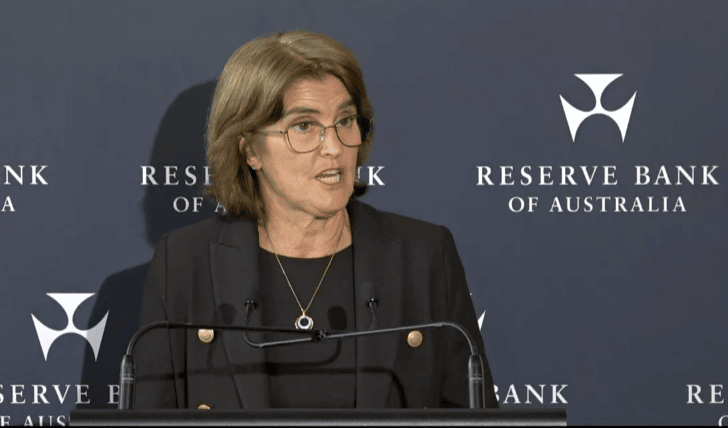Australian Dollar: RBA "More Hawkish" Than Expected, GBP/AUD Retreats
- Written by: Gary Howes
-

RBA Governor Michelle Bullock delivers the post-decision statement and answers questions fielded by the press. Image: Pound Sterling Live, RBA.
The Australian Dollar rose broadly after the Reserve Bank of Australia's June policy update proved more 'hawkish' than the market expected.
The Pound to Australian Dollar is a third of a per cent lower on the day at 1.9157 after the RBA left interest rates unchanged and expressed new concerns about the persistence of inflation, hinting that it is a little less inclined than before to consider cutting interest rates.
The June statement's opening heading reads, "inflation remains above target and is proving persistent." This compares with May's headline, "inflation remains high and is falling more gradually than expected."
The Australian Dollar is a third of a per cent higher on the day against the U.S. Dollar (0.6631) and is stronger by a similar margin against the Euro (1.6178).
Market pricing showed investors' expectations for a rate cut in 2024 fell slightly following the RBA update, which can explain AUD outperformance.
"The statement has evolved in a slightly more hawkish direction than we anticipated, including in the final paragraph with the addition of the Board being willing to 'do what is necessary to achieve that outcome'," says Adam Boyton, Head of Australian Economics.
Speaking to the press, Governor Michelle Bullock said the government's new tax cuts would potentially boost consumption growth in the coming months. This would work against the RBA's efforts to reduce demand, which would help bring inflation down.
Crucially, Bullock said the RBA board did not discuss cutting interest rates but did discuss raising them amidst strong consumption.
"We retain our base case that the next move in the cash rate is down. And we have November pencilled in for the first rate cut. But given the challenging underlying inflation backdrop, as well as a labour market that is loosening more gradually than expected, the runway is shortening between now and November. The risk to our call is increasingly moving towards a later start date for an easing cycle," says Gareth Aird, an economist at Commonwealth Bank of Australia.
The RBA is expected to be one of the last developed market central banks to cut interest rates in this cycle, which can support the Australian Dollar.
"We only expect the Bank to start easing policy next year," says Marcel Thieliant, Head of Asia-Pacific at Capital Economics. "headline inflation, as well as inflation excluding volatile items and travel, had not fallen any further between April and December."
Kit Juckes, an analyst at Société Générale, says that short-term interest rate differentials suggest "a bullish bias" for the Aussie Dollar against a number of currencies, including the U.S. Dollar, New Zealand Dollar, and Euro.











